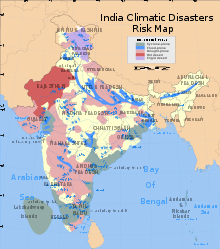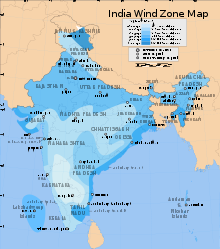
Back Desastres naturales en India Spanish Zabtarewar ƙasa a indiya Hausa भारत में प्राकृतिक आपदाएं Hindi Ọdachi ndị na-emere onwe ha na India IG ಭಾರತದಲ್ಲಿನ ನೈಸರ್ಗಿಕ ವಿಕೋಪಗಳು Kannada
This article is written like a personal reflection, personal essay, or argumentative essay that states a Wikipedia editor's personal feelings or presents an original argument about a topic. (May 2013) |
 |
 |
Natural calamities in India, many of them related to the climate of India, cause massive losses of life and property. Droughts, flash floods, cyclones, avalanches, landslides brought by torrential rains, and snowstorms pose the greatest threats. A natural disaster might be caused by earthquakes, flooding, volcanic eruption, landslides, hurricanes etc. In order to be classified as a disaster, it will need to have a profound environmental effect and/or human loss and frequently incurs a financial loss.[1] Other dangers include frequent summer dust storms, which usually track from north to south; they cause extensive property damage in North India[2] and deposit large amounts of dust and dirt from arid regions. Hail is also common in parts of India, causing severe damage to standing crops such as rice and wheat and many more crops and effects many people.
- ^ Goswami BN, Venugopal V, Sengupta D, Madhusoodanan MS, Xavier PK (2006). "Increasing trend of extreme rain events over India in a warming environment". Science. 314 (5804): 1442–1445. Bibcode:2006Sci...314.1442G. doi:10.1126/science.1132027. PMID 17138899. S2CID 43711999.
- ^ Balfour 1976, p. 995.